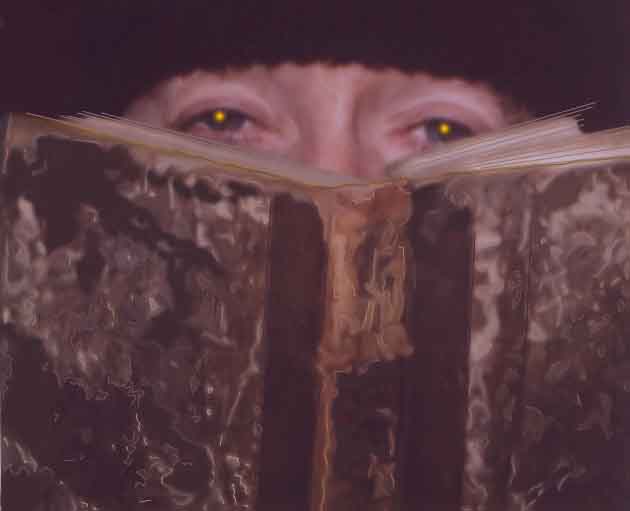









KEGAN/TERRY/KEGAN by J.J. Kegan McFadden was shown at Gallery 803 in Winnipeg from 30 May to 30 June, 2010.
[First published as "Kegan McFadden" in Border Crossings magazine, December/January/February, 2010, 81-82.]
It makes sense to address at once both aspects of the professional identity of the artist/curator (or curator/artist) J.J. Kegan McFadden.
A good training in art history is good for a contemporary artist, if we are to take Jeff Wall and Ad Rheinhardt as examples. McFadden trained recently as a curator and art historian at UBC, but he has no training as an artist. Schools like the University of British Columbia and Bard teach contemporary curating in conjunction with their other art and art history programs, but curatorial degrees are new and rare.
Very few Winnipeg artists make photo-text work, and so I speculate that the influence of UBC artists such as Ken Lum would have been important to McFadden.
Today's working curators have all sorts of backgrounds, but most, I'd venture -- myself included - are trained as artists. In Canada one thinks of Jan Allen at the Agnes Etherington Art Centre, Peter Dykhuis at Dalhousie Art Gallery, Andrew Hunter and Allan Harding Mackay in Kitchener, and Jeffrey Spalding in Nova Scotia. If these names are familiar, you'll instantly recognize how differently each artist/curator constructs her public persona, or has it constructed for them, so as to avoid professional conflicts of interest. Some, like Dykhuis and Allen, keep their lives as artists and curators completely separate, while others -- most notably Andrew Hunter -- mix up professional roles as if mixing up genres. As Jan Allen put it in a recent e-mail to me: "Artists are allowed/encouraged to be curators, but those known primarily as curators are subtly but systemically discouraged from crossing the line." McFadden is part of a new generation that may have grown up thinking of curating and art making as more or less the same thing.
He organizes art shows for the Winnipeg artist-run centre Platform, and he also works as a freelance writer and curator, but this is his first solo exhibition as an artist. Contemporary curating is a fungible thing, and the skills -- many of them managerial -- match those of many contemporary artists. Curator/artists can have just about anything made for them on spec at an hourly rate, even hyper-realist paintings. In this case, McFadden has assigned collaborators to make photographs, stands and light boxes for him.
McFadden's calm understated solo installation provoked questions about curators who make art, but also questions about fathers, sons and gay life.
The show included shelf-mounted photographs and light box texts that told a generational story of his family. Eyeglasses, belts and shirts from three male generations of McFadden's family were the subject of photographs mounted as if in a department store -- flat and horizontal. One's impulse was to pick up an item, which is, of course impossible.
The light box texts were poetic, about childhood memories - pleasant memories. McFadden was personal but unrevealing about his youth: could it have been that blissful? The show was decorous. Nowhere was an explicit indication that artist is openly gay.
McFadden cleverly presents a set of poetic questions in both his artistic and curatorial work that take on a viewer's assumptions about artist/curator roles and gay and straight culture. McFadden "queers" both his curatorial and artistic work. His recent touring exhibition 27xDoug: Portraits by Larry Glawson is a tightly-edited show about Glawson's muse and husband Doug Melnyk. We are likely to assume that Glawson's muse worship is like that of heterosexual male artists such as Picasso who made/make odes to women, but heterosexuality and homosexual muse relations are not really symmetrical. Polite society celebrates Pride Week once a year, and so the frisson of controversy in McFadden's projects are only ever mildly transgressive.
Glawson's art, which he presents as a curator, and McFadden's own art at Gallery 803 are presented as if explicit references to gay sexuality are unnecessary. Is this the typical position of today's young gay artist? There is not a hint of stridency, embattled opinion or anger in McFadden's artistic or curartorial practice. Perhaps he means to say that in order to "queer" the discourse he will treat "queer" as normal.
Is Canadian culture, which mostly prides itself on tolerance, ready for "gay normal" as it thinks it is?. In an artist's statement, McFadden talks about attempting to "systematically categorize [a] patriarchal lineage.... photographs of one's belongings tend to offer only the slightest superficial notion of the person. Though, if examined further, we may guess at categories of class, employment, leisure activities, and other variables that can assist in further identifying the wearer's socio-economic position and perhaps even offer insights into their lives."
But what do we need to know about Kegan, Kelly, and Terry McFadden in order to understand that "patriarchal lineage"? Interestingly, there is not enough information here to say much about the actual relationships because the texts here show nothing but familial harmony. McFadden never addresses directly the conflict that one would instantly assume of the relationship between a gay son/grandson and his father and grandfather. Is he presenting an ideal or an idealized world of contemporary acceptance and family harmony? No struggles? No fights?
I think not. Again, I think that the elisions are deliberate, and in McFadden's curatorial and artistic work, the world is presented as it should be or could be, and not as it is.

|
|